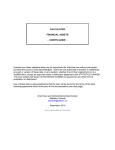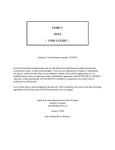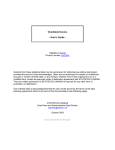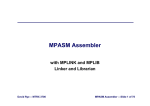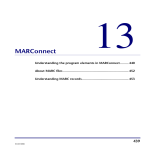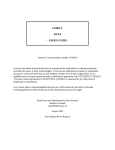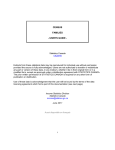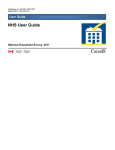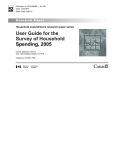Download User's Guide - Migration Estimates
Transcript
MIGRATION ESTIMATES - USER'S GUIDE - Statistics Canada product number 91C0025 Extracts from these statistical data may be reproduced for individual use without permission provided the source is fully acknowledged. Users are not authorized to transfer or redistribute any part or version of these data, in any medium, whether it be in their original form or in a modified form, except as approved under a distribution agreement with STATISTICS CANADA. The prior written permission of STATISTICS CANADA is required for any other form of publication or distribution. Use of these data is acknowledgment that the user will be bound by the terms of the data licensing agreement which forms part of this documentation (see next page). Small Area and Administrative Data Division Statistics Canada [email protected] September 2002 Aussi disponible en français END-USE LICENCE AGREEMENT COPYRIGHT The Government of Canada (Statistics Canada) is the owner or a licensee of all intellectual property rights (including copyright) in this data product. In consideration of your payment of the requisite fee, you or your organisation, as the case may be, (hereinafter referred to as the "licensee") are granted a non-exclusive, nonassignable and non-transferable licence to use this data product subject to the terms below. This license is not a sale of any or all of the rights of the owner(s). TERMS OF USE 1. All copyright and proprietary notices and all conditions of use associated with the data product must be communicated to all users of the data product. 2. The licensed organisation shall not transfer this data product to or store the data product in any electronic network for use by more than three (3) users unless it obtains prior written permission from Statistics Canada and pays any additional fees. 3. The licensee shall not lend, rent, lease, sub-licence, transfer or sell any part of the data product nor any right granted under this agreement to any person outside the licensed organisation or to any other organisation. 4. The licensee shall not disassemble, decompile or in any way attempt to reverse engineer any software provided as part of the data product. 5. The licensee shall not use any part of the data product to develop or derive any other data product or data service for distribution or commercial sale. 6. The licensee is granted reasonable rights of use of the content of this data product only for personal, corporate or public policy research, as well as for educational purposes. This permission includes the use of the content in analyses and the reporting of results and conclusions, including the citation of limited amounts of supporting data extracted from the data product in such documents. In such cases, the source of the data must be acknowledged in all such documents and communications by providing the following source citation at the bottom of each table and graph: Source (or "Adapted from", if appropriate): Statistics Canada, name of product, catalogue number of product, reference date of product. 7. The Licensee shall obtain approval from Statistics Canada, before publishing any significant volumes of material extracted from the data product in any medium. 8. Any violation of this license renders it void and of no effect. This agreement will terminate automatically without notice if the licensee fails to comply with any term of this agreement. In the event of termination, the licensee must immediately return the data product to Statistics Canada or destroy it and certify this destruction in writing to Statistics Canada. WARRANTIES AND DISCLAIMERS This data product is provided "as-is", and Statistics Canada makes no warranty, either express or implied, including but not limited to, warranties of merchantability and fitness for a particular purpose. In no event will Statistics Canada be liable for any direct, special, indirect, consequential or other damages however caused. ACCEPTANCE OF TERMS It is YOUR RESPONSIBILITY to ensure that your use of this data product complies with these terms and to seek prior written permission from Statistics Canada for any uses not permitted or not specified in this agreement. Any infringement of Statistics Canada's rights may result in legal action. ANY USE WHATSOEVER OF THIS DATA PRODUCT SHALL CONSTITUTE YOUR ACCEPTANCE OF THE TERMS OF THIS AGREEMENT. For further information please contact: Licensing Services Marketing Division, Statistics Canada R.H. Coats Building, 9th floor, section A Ottawa, Ontario K1A 0T6, Canada E-mail: [email protected] Telephone: (613) 951-1122 Fax: (613) 951-1134 © Statistics Canada, 2002 i TABLE OF CONTENTS INTRODUCTION........................................................................................................................... 1 SECTION I -- THE DATA ............................................................................................................. 2 Data Source......................................................................................................................... 2 Timeliness ........................................................................................................................... 2 An Outline of the Methodology .......................................................................................... 2 Geocoding ............................................................................................................................... 3 Estimation of Dependents ....................................................................................................... 3 Migrant Taxfilers and Dependents.......................................................................................... 4 Coverage Correction ............................................................................................................... 4 Data Quality ........................................................................................................................ 4 Availability of Data............................................................................................................. 5 SECTION II -- THE DATA TABLES............................................................................................ 6 Data Table Contents............................................................................................................ 6 SECTION III -- GLOSSARY OF TERMS..................................................................................... 8 WE INVITE YOUR COMMENTS .............................................................................................. 10 LIST OF DATA PRODUCTS AVAILABLE............................................................................... 11 REGIONAL REFERENCE CENTRES........................................................................................ 12 ii MIGRATION ESTIMATES FROM TAX RECORDS FOR CENSUS DIVISIONS/CENSUS METROPOLITAN AREAS INTRODUCTION This report presents migration estimates by census division (CD) and/or by census metropolitan area (CMA). Five-year comparisons as shown on our printed standard tables enable users to see the pattern of movement by Canadians, as well as immigration and emigration flows to and from Canada. The data tables are updated on a yearly basis. Migration estimates by CMA are available since 1992-93. 1 SECTION I -- THE DATA Data Source The migration estimates are derived from a comparison of addresses from individual income tax returns for two consecutive years. The period of reference extends from April of one year to April of the following year. A summary of the methodology is provided later in this document. Timeliness Migration estimates are available by census division from 1976-77 (and by census metropolitan area from 1992-93). Preliminary data on international migration and final data on internal migration are normally available from 15 to 18 months after the income tax deadline. Revised (final) data on international migration are produced 12 to 15 months after the preliminary data. Note that only the international portion of the migration figures is subject to revision. An Outline of the Methodology The data developed from the taxation records are estimates of migration flows between census divisions or census metropolitan areas by gender and broad age groups (under 18, 18 to 24, 25 to 44, 45 to 64 and 65 and over). Starting with the 1996-97 data, estimates are produced for 1996 census division boundaries. For 1992-93 through to 1995-96, the data were produced for 1991 census division boundaries. For the 1986-87 through 1991-92 period, the census division boundaries corresponded to those defined in the 1986 Census. For the years 1981-82 to 1985-86, the boundaries used are those defined in the 1981 Census and in the previous years the 1976 census boundaries are used. Migration flows for census metropolitan areas are available only since 1992-93, and the boundaries of the 26 CMAs are based on 1991 Census definitions for the period 1992-93 to 1995-96. Beginning with the 1996-97 estimates, the CMA boundaries are based on 1996 Standard Geographic Coding. The development of these data involves four main steps: 1) Geocoding of tax records; 2) Estimation of non-filing dependents of taxfilers, by age group and gender; 3) Identification of the number, age group and gender of migrant taxfilers; and 4) Adjustment for the population not covered by the Canada Customs and Revenue Agency Taxation system. 2 Step 1 - Geocoding The geographic coding of census divisions and census metropolitan areas on the tax records is done primarily on the basis of the postal code, which is part of the mailing address. In some cases, other pieces of information were used in place of a missing postal code. Since the 1989 tax files, over 99% of the records could be assigned a census division code. Step 2 - Estimation of Dependents Since the source file has no direct information on the number and characteristics of nonfiling dependents, this information must be imputed. Up to the 1987-88 period, this was based on the relationship between the dollar value of the total personal exemptions claimed and the number of dependents. A reference table was established relating an estimate of the average number of dependents by age group and gender to filers in a given age-gender-marital status-total personal exemption class. This table was produced each year using a sample file of taxfilers containing information on the exact number of dependents and their relationship to the filer in addition to the characteristics of the filer. Other demographic information such as gender ratios and the age distributions of husbands and wives were also used to distribute dependents by age and gender. The current system uses the estimation of taxfilers' dependents from the T1 family file (T1FF). The family system creates families by linking all filing family members together and estimates non-filing members from information on the taxfilers' returns,1 based on such information as deductions/tax credits for dependents. For example, the family system imputes a non-filing spouse wherever a filer has declared him/herself married but was not linked with a filing spouse.2 1 see report "Description of the Methodology Used to Create Migration Data from Tax Records" updated by Judy Reid, Small Area and Administrative Data Division: February 1998. 2 see Lucaciu, Daniela and Shelley Harris, "Overview of T1FF Processing", SAADD: 1994. 3 Step 3 - Migrant Taxfilers and Dependents The main source file used contains the basic demographic and geographic information on each taxfiler (and dependent) and covers approximately 95% of the total population. The migrant taxfilers are identified by comparing current and previous census divisions or census metropolitan areas of residence. Taxfilers' non-filing dependents are assumed to have the same migration behaviour as that of the filer to whom they are assigned. Step 4 - Coverage Correction The final step in the estimation process is an adjustment for coverage, done by age and gender at the census division/census metropolitan area level. Population estimates by CD/CMA are used to create coverage ratios. In a few cases where coverage is abnormally high or low, provincial adjustment ratios are used in place of the CD/CMA ratio. The adjustment ratios are applied to the counts of out-migrants derived in Step 3 to obtain an estimate of total migration. The basic assumption is that the population not covered by the taxation system has the same migration rate as that covered by it. The estimates of international migration are prorated to agree with provincial estimates provided by the Demography Division of Statistics Canada. Data Quality Based on a detailed evaluation of the estimates for the intercensal period of 1986-91, a number of observations can be made regarding migration estimates for Census divisions: (a) 3 Overall, the estimates of migration are of good quality. It is, however, difficult to make exact comparisons to other annual estimates of migration flows at the census division level. The estimates of net migration have been used to produce population estimates and these have been compared to the 1991 Census counts. The average absolute difference for 1991 was 2.3%. In 12 of 182 cases (6%)3 the deviation exceeded 5% and in 3 cases, the deviation exceeded 10% (this does not include Quebec census divisions). These deviations are smaller than those obtained from other estimation methodologies and indirectly indicate the quality of the net migration data. It has not been possible to do much evaluation of the flow data. Montgomery, March 1993: p 15 4 (B) In addition to the estimates of migration based on tax records, Demography Division of Statistics Canada also produces estimates of interprovincial migration which are based on Child Tax Benefit records. The concepts underlying these estimates differ from the concepts used in the tax-based estimates. More specifically, the Child Tax Benefit data estimates monthly moves while the tax data tracks annual moves. No comparable study has yet been done to examine the CMA coverage. Availability of Data Migration estimates are available by census division from 1976-77, and by census metropolitan area from 1992-93. For the 1976-81 period, no preliminary migration flows between census divisions were calculated. Adjustments were not made at the international level although evaluations indicated the estimates of international migration were too low. For the period from 1981-82 to 1984-85, migration estimates from tax records were produced twice a year, the first time using a preliminary tax file from the Canada Customs and Revenue Agency (available with a 6-9 month time delay) and the second with a more complete tax file (available with a 12-15 month time delay). Because the differences between the two sets of estimates were not large, beginning with the 1985-86 estimates, only one series of estimates was produced. The final file has been used since 1985-86. Beginning with the 1981-82 estimates, the data on immigration and emigration have been prorated to make them consistent with the most currently available estimates produced at the provincial level by Demography Division of Statistics Canada. Two data series are produced to accommodate data updating done by Demography Division. 1. Preliminary Estimates (15-18 month time lag). The international component is prorated to the preliminary estimates of international migration provided by Demography Division; and 2. Revised (Final) Estimates (27-33 month time lag). The international component is prorated to the final estimates of international migration provided by Demography Division, while the counts of internal migration remain unchanged. Each of the above estimates is identified in tables by the letters "P" (preliminary) and "R" (revised - final). 5 SECTION II -- THE DATA TABLES Number of Tables There are four standard data tables, each with a five-year comparison of migration: Table A: Table B: Table C: Table D: By Province of Origin/Destination By Age Group By Type of Migration and Gender Flows by Census division of Origin/Destination, or by CMA/non-CMA of Origin/Destination Note: A five-year comparison is not always possible for census divisions due to boundary changes over time. This five-year comparison was not possible for Quebec nor for some census divisions in British Columbia due to major census division boundary changes beginning in 199293, and based on 1991 census divisions, and again in 1996-97 based on 1996 census divisions. For these areas, comparable data are provided according to the old boundaries up to and including 1991-92 or 1995-96, and according to the new boundaries since 1996-97. Data Table Contents Table A - By Census Division or Census Metropolitan Area of Origin and of Destination Each page of this table highlights flows: in-, out- and net flows for a specific province, a specific census division (CD) or any one of the 26 census metropolitan areas (CMAs), including nonCMA areas for each province. Thus the flows between the provinces, as well as between CDs and CMAs are shown. The name of the CD or CMA for which the table is reporting appears in the upper left corner, along with the CD/CMA number and the province in which it is located. The first row of column one lists a province or territory as origin (with the given CD/CMA as destination). The second row lists the province or territory as destination (with the given CD/CMA as origin). The third row shows the net migration for the given CD/CMA with the province or territory. This is done for each province or territory. Tables B and C - Age Group, Type of Migration, and Gender Both Tables B and C list in, out and net migration for the highlighted CD or CMA for a five-year period. Table B gives the age groups of migrants. Table C shows migration by "type": interprovincial, intraprovincial and international migration (see glossary) and also gives the figures for type of migration by gender. Note to Tables A, B and C: Provincial totals provided include intraprovincial migration. 6 Table D - Flows by Census Division/Census metropolitan area of Origin/Destination For each census division or census metropolitan area, Table D gives details of the flows for that CD or CMA. That is, a list is given of the CDs or CMAs with which the selected CD or CMA exchanged any people. Note that the major flows are ranked in the table by net migration. The flows for the past five years are shown on the printed tables, though the ranking is according to the most recent period. 7 SECTION III -- GLOSSARY OF TERMS Census division (CD) Refers to the general term applying to counties, regional districts, regional municipalities and five other types of geographic areas made up of groups of census subdivisions. In Newfoundland, Manitoba, Saskatchewan and Alberta, the term describes areas that have been created by Statistics Canada in cooperation with the provinces as an equivalent for counties. Census metropolitan area (CMA) The general concept of census metropolitan areas (CMA) is one of a very large urban area together with adjacent urban and rural areas that have a high degree of economic and social integration with that urban area. Emigration Movement from an area in Canada to another country. Gross migration flow Sum of the number of migrants between two geographic areas. It is obtained by adding the number of in-migrants to the number of out-migrants. Immigration Movement to an area in Canada from another country. In-migration Movement to a census division or census metropolitan area from elsewhere inside or outside Canada. Internal migration Movement between two census divisions or census metropolitan areas within Canada. Internal migration is divided in two categories: interprovincial and intraprovincial migration. International migration Movement between an area in Canada and another country. International migration is divided in two categories: immigration and emigration. Interprovincial migration Movement between census divisions or census metropolitan areas located in two different provinces. The province of departure is the Aprovince of origin@ and the province of arrival is the Aprovince of destination@. 8 Intraprovincial migration Movement between two census divisions or census metropolitan areas located within the same province. The CD/CMA of departure is the CD/CMA of Aorigin@ and the CD/CMA of arrival is the CD/CMA of Adestination@. Migration Movement between two geographic areas during the period covered by the estimates. Within Canada, the geographic area of reference is the census division or the census metropolitan area. Other countries are considered as one geographic area. Net migration Difference between the number of in-migrants and the number of out-migrants. Out-migration Movement out of a census division or census metropolitan area to elsewhere inside or outside Canada. 9 WE INVITE YOUR COMMENTS! We are always working on ways to improve our products. The comments we receive concerning quality and presentation are essential to meet this objective. If you have any suggestions in this regard, we encourage you, the user, to provide us with your comments. Data in many forms Statistics Canada disseminates data in a variety of forms. In addition to publications, both standard and special tabulations are offered. Data are available on the Internet, compact disk, diskette, computer printouts, microfiche and microfilm and magnetic tape. Maps and other geographic reference materials are available for some types of data. Direct online access to aggregated information is possible through CANSIM, Statistics Canada's machine-readable database and retrieval system. How to obtain more information Inquiries about these data and related statistics or services should be directed to: Client Services Small Area and Administrative Data Division Statistics Canada Room 1306, Main Building Ottawa, Ontario K1A 0T6 Phone: (613) 951-9720 Fax: (613) 951-4745 Toll-free 1-888-652-8443 Toll-free 1-888-652-8444 [email protected] Local Statistics Canada Reference Centres are listed on the last page. You can also visit our World Wide Web site at http://www.statcan.ca. Toll-free access is provided for all users who reside outside the local dialling area of any of the Regional Reference Centres. National enquiries line 1-800-263-1136 National telecommunications device for the hearing impaired 1-800-363-7629 Order-only line (Canada and the United States) 1-800-267-6677 National Toll-free Fax Order line 1-877-287-4369 Standards of service to the public Statistics Canada is committed to serving its clients in a prompt, reliable and courteous manner and in the official language of their choice. To this end, the agency has developed standards of service which its employees observe in serving its clients. To obtain a copy of these service standards, please contact your nearest Statistics Canada Regional Reference Centre. 10 LIST OF DATA PRODUCTS AVAILABLE The Small Area and Administrative Data Division of Statistics Canada tabulates statistical data derived from administrative records - most notably, the taxfile. The resulting demographic and socio-economic databanks available are listed in the table below, along with their identifying product number and the usual release dates. Product name Product number Release date RRSP Contributors 17C0006 November RRSP Contribution Limits (Room) 17C0011 December Canadian Savers 17C0009 November Canadian Investors 17C0007 November Canadian Investment Income 17C0008 November Canadian Taxfilers 17C0010 November Canadian Capital Gains 17C0012 November Charitable Donors 13C0014 December Neighbourhood Income and Demographics 13C0015 July Economic Dependency Profiles 13C0017 July Labour Force Income Profiles 71C0018 July Families 13C0016 July Seniors 89C0022 August Migration Estimates 91C0025 September 11 REGIONAL REFERENCE CENTRES The Advisory Services Division of Statistics Canada provides an information dissemination network across the country through nine regional Reference Centres. Each Reference Centre has a collection of current publications and reference documents that can be consulted or purchased, along with microcomputer diskettes, CD-ROMs, maps, and other products. Copying facilities for printed materials are available on site. Each Reference Centre provides a wide range of additional services. On the one hand, the Dissemination Services: a free telephone inquiries line for the most recent basic data. On the other hand, Advisory Services: identification of your needs, establishing sources or availability of data, consolidation and integration of data coming from different sources and development of profiles, analysis of highlights or tendencies and, finally, training on products, services, Statistics Canada concepts and also the use of statistical data. For more information, you can call the Reference Centre closest to you by dialling the number on the following page; if you are outside the local calling area, please dial the national toll-free inquiries number and you will be in contact with the Regional Reference Centre serving your area. National Toll-Free Inquiries Line (Canada and United States): 1-800-263-1136 Telecommunications Device for the Hearing Impaired: 1-800-363-7629 Toll-Free Order Only Line (Canada and United States): 1-800-267-6677 National Toll-Free Fax Order Line (Canada and United States): 1-877-287-4369 12 ATLANTIC REGION ONTARIO REGION Serving the provinces of Newfoundland and Labrador, Nova Scotia, Prince Edward Island and New Brunswick. Serving the province of Ontario except the National Capital Region. Serving Alberta and the Northwest Territories: Statistics Canada Advisory Services Arthur Meighen Building, 10th Floor 25 St. Clair Avenue East TORONTO, Ontario M4T 1M4 Statistics Canada Advisory Services Pacific Plaza, Suite 900 10909 Jasper Avenue N.W. EDMONTON, Alberta T5J 4J3 Toll-free: 1-800-263-1136 Local Calls: (416) 973-6586 Fax number: (416) 973-7475 E-mail: [email protected] Toll-free: 1-800-263-1186 Local calls: (780) 495-3027 Fax number: (780) 495-5318 E-mail: [email protected] QUEBEC REGION PRAIRIE REGION PACIFIC REGION Serving the province of Quebec (except the National Capital Region) and the territory of Nunavut. This region has three Reference Centres serving the provinces of Manitoba, Saskatchewan, Alberta and the Northwest Territories. Serving the province of British Columbia and the Yukon Territory. Statistics Canada Advisory Services 1741 Brunswick Street 2nd Floor, Box 11 HALIFAX, Nova Scotia B3J 3X8 Toll-free: 1-800-263-1136 Local calls: (902) 426-5331 Fax number: (902) 426-9538 E-mail: [email protected] Statistics Canada Advisory Services 200 René Lévesque Blvd. West Guy Favreau Complex 4th Floor, East Tower MONTREAL, Quebec H2Z 1X4 Toll-free: 1-800-263-1136 Local calls: (514) 283-5725 Fax number: (514) 283-9350 E-mail: [email protected] Serving the province of Manitoba: Statistics Canada Advisory Services Via Rail Building, Suite 200 123 Main Street WINNIPEG, Manitoba R3C 4V9 NATIONAL CAPITAL REGION Toll-free: 1-800-263-1186 Local calls: (204) 983-4020 Fax number: (204) 983-7543 E-mail: [email protected] Serving the National Capital Region. Serving the province of Saskatchewan: Statistics Canada Statistical Reference Centre (National Capital Region) R.H. Coats Building, Lobby Holland Avenue OTTAWA, Ontario K1A 0T6 Statistics Canada Advisory Services Park Plaza, Suite 440 2365 Albert Street REGINA, Saskatchewan S4P 4K1 Toll-free: 1-800-263-1136 Local calls: (613) 951-8116 Fax number: (613) 951-0581 E-mail: [email protected] Toll-free: 1-800-263-1186 Local calls: (306) 780-5405 Fax number: (306) 780-5403 E-mail: [email protected] 13 Statistics Canada Advisory Services Library Square Office Tower 600-300 West Georgia Street VANCOUVER, British Columbia V6B 6C7 Toll-free: 1-800-263-1136 Local calls: (604) 666-3691 Fax number: (604) 666-4863 E-mail: [email protected]



















